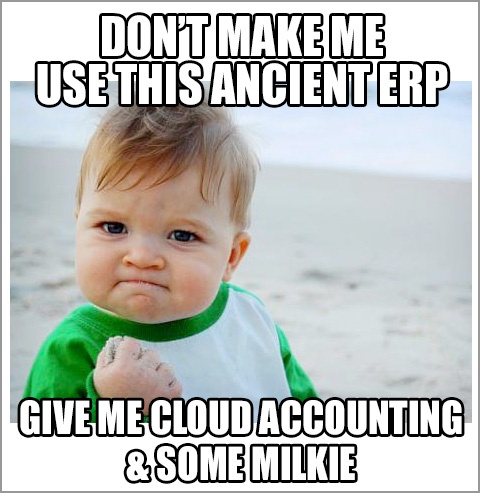
The Five Most Frequent ERP Implementation Mistakes
Today’s ERP systems are completely different than how they were once designed. While the definition still stands for “Enterprise Resource Planning”, the actual resources an ERP system manages have drastically changed since the dot-com boom.
ERP used to be focused on financials due to the importance of inventory. It made perfect sense since, until the 1990s, the majority of organizations dealt with physical materials and expensive capital equipment. This equipment was at the heart of the product life-cycle with associated manufacturing processes that would determine how firms could compete. Therefore, the decisions on what to buy and sell came from Finance, Accounting or shared service teams. However, the types of businesses have changed in the past couple decades. Now a majority of organizations are in the Information or Service industry. Even those within manufacturing have “commoditized” the actual product development side of their business, and are run like service businesses. Now the most expensive cost is human capital and not raw materials. Hence areas that were once looked at as “nice-to-haves” have gained in importance since they have a more direct path toward an enterprise’s bottom line.
The change has left vendors such as PeopleSoft and Oracle racing to re-invent their core products to align with industry best practices. Newer ERP vendors, such as Workday, have become leaders not just because they leveraged a cloud-based infrastructure from the start, or that they can provide flexibility and configuration changes without the need for code updates, but because they can fit to an organization’s human capital needs rather than organizations modifying their business processes to work with their ERP system.
In addition, a more modular approach from savvy vendors now gives their clients alternative implementation paths that seem less daunting and capital intensive than a big-bang approach with all aspects of Financials and Human Capital Management installed on day one. Smart vendors go-ahead and bundle subscription packages to include services not in a client’s current implementation. They hope clients will (and do) ask themselves why they don’t implement the additional functionality if it is included in their licensing agreement anyway.
Like clockwork, ERP vendors present buyers with a utopian dream of maximum efficiencies with no need for external integrations that could slow down business processes, or consolidated reporting that can pull data from all organizations, and every functional area in both the Financials and Human Capital Management worlds.
Unfortunately, there are dozens of ERP pitfalls as you navigate through a new implementation. Some of these can turn the dream of an automated, efficient system into a nightmare that keeps going and going.
Here are just a few that trip up even the largest clients:
1. Third Party Delays / Issues
The primary ERP vendor can tell you how great and automated their integrations will be, but they only control one side of the solution. The other side is almost never as motivated to help a client succeed as there is no accountability. They will have resources not contractually obligated to assist you or your firm’s vision. These people will not run on your schedule, and they probably have a hundred other clients of their own they are assisting as well. At best, your ERP vendor will tell you this in Appendix D or E as a risk, but will never fully explain that they can’t control these third parties

2. Change Management
Exactly 100% of the time there is either no money or far too little set-aside to train employees on the new software and the business processes that come with it. No thought goes into the time required to develop the proper communications to allow for a smooth transition.

3. Data Cleansing
Clients rarely evaluate the effort required to prepare current data for a new ERP system load. In addition, today’s vendors are careful to say the client is responsible for the quality of the data that goes into the system. If there is dirty data transferred into the system, it will be much harder to clean it up after it is set-up. In addition, the data may need to be mapped to a future-state structure defined during the requirements stage. These tasks require multiple Business Analysts time for weeks, or months. This is never accounted for accurately in the SOW.

4. Customization over Configuration
Vendors try and build a product that is flexible enough for various customers while keeping the system controllable to manage. Fundamental adjustments to the software are not recommended as they require a lot of maintenance and support. Instead clients are advised to modify objects as little as possible through configuring existing functionality. Inevitably though, customers will try and adjust the software to meet their current requirements, especially if it comes from a key stakeholder such as an Officer. This is rarely a smart idea as it costs more to maintain, but also prevents clients from using processes that are considered best practice.

5. Actual Resource Efficiencies
“You can do more with less!” – It’s a classic sales pitch from ERP cloud vendors. “If you use our system, we will handle the IT infrastructure and system upkeep in addition to simplifying the functional business processes so less administrators are needed.” Sounds great, but, it never happens, period. The idea of automating manual processes that eat up resource time is exciting for every manager, director and executive. “Finally, we can get rid of all the spreadsheets kept in ten locations and updated by five people every week. We can then reduce our headcount by XYZ and save millions!” — It never happens without trade-offs so expectations need to be lowered from the start.

These are just a few of the top implementation issues that come up over and over. Since there is no incentive for vendors to provide additional guidance for their clients, and the issues are relatively unique to these types of implementations, clients need to be aware prior to signing any paperwork as well as throughout the set-up process.
I’m interested to know if you have had similar issues.
About the author: David Apollon is the managing director at 9Nation Inc., a consulting firm founded ten years ago to help Fortune 500 companies as well as growth-stage firms handle special IT and strategic projects including ERP, CRM and cloud-based implementations. David has led over 75 corporate programs, projects and PMO initiatives in the past 20 years.
